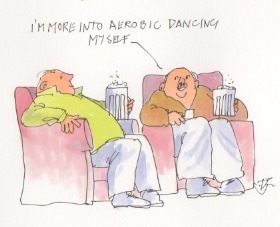EXERCISE – BACK TO FIRST PRINCIPLES
So far, dear Reader, I have been a bit haphazard in the selection of the exercise based subjects which I have addressed in this Blog. I have tried to be topical which may be confusing. So for 2020 I will have bit of structure, starting at the beginning – what is exercise?
What is exercise?
There is a huge army of definitions of exercise. Among a number from the Oxford English Dictionary, these seem to me to be the least worst:
- “Bodily movement produced by the contraction of skeletal muscle that substantially increases energy expenditure”
- “Activity requiring physical effort, carried out to sustain or improve health and fitness”.
I am not entirely happy with either – I doubt that the intention to sustain or improve health is a necessary element – it’s just a side effect. The World Health Organisation defines physical activity as:
“Any bodily movement produced by skeletal muscles that requires energy expenditure.”
I think that this understates the level of exertion required to qualify as exercise. So, failing a convincing definition, maybe a list of synonyms gives a better flavour of the true meaning of exercise:
“physical activity, movement, exertion, effort, work, workout, training, drilling, gymnastics, sports, games, PE (physical education), PT (physical training), aerobics, step aerobics, jogging, running, circuit training, aquarobics, calisthenics, isometrics, eurhythmics, keep-fit, dancercise, bodybuilding, physical jerks, daily dozen….”.
And it is more that all of these – none of which, apart perhaps from “games”, really covers the fun element which is such an important a part of exercise.
How about this? “Exercise is purposeful activity which uses the voluntary muscles”. Still not good enough – is reaching out for a doughnut really exercise?
Muscles
And what are “voluntary” muscles anyway? Well your muscles are divided into three distinct varieties:
1. Voluntary muscles, sometimes referred to as striated muscles because of their stripy appearance under the microscope, are those movements over which we have control. Like say the biceps. Think that you want to bend your arm, put it into action and hey presto you contract your biceps and your arm bends.
2. Involuntary muscles, sometimes referred to as smooth muscles, are those which perform the vital activities of the body and over which we have no control – they just get on with it, like the muscles of the gut which labour away moving food down the gastrointestinal tract. Or the ocular muscles which control the pupil – they respond to light but not to any conscious thought process.
3. Cardiac muscle – the heart is a very specialised form of involuntary muscle which we will meet in some detail later.
Muscles and activity
Animals need to move to survive and higher life forms, so-called vertebrates, have evolved muscles and bones for this purpose. Each animal’s musculo-skeletal system has evolved to suit its own survival needs – the cheetah has a system designed for speed to enable it to catch its prey and likewise the antelope has a system designed for speed to prevent itself from being eaten by the cheetah. For other species strength may be more important than speed. Think of the tiger which can tear its prey limb from limb. For every animal there is an optimal mixture of speed and strength to enable it to survive and procreate efficiently.
Human survival
Evolution has given humans a musculo-skeletal system of great versatility. We are not immensely strong nor immensely fast – but we do have the greatest intelligence in the animal kingdom and we use our brain power to make the most efficient use of this versatility. Man has evolved to be a highly efficient hunter-gatherer – to hunt animals and to gather edible plants for our sustenance. For most of human history that has been the main function of our muscles. Primitive man took a lot of exercise because that is what he had to do to survive.
Modern technology
The evolution of society did not reduce the need of the manual worker to exert himself or herself, though it did allow the ruling classes to let up a bit. The real change came with the Industrial Revolution and the development of machines to take over the physical aspects of the daily grind. Next time I will look at the effect that has had on physical activity in general.
Subscribe to the blog
Categories
- Accelerometer
- Alzheimer's disease
- Blood pressure
- BMI
- Cancer
- Complications
- Coronary disease
- Cycling
- Dementia
- Diabetes
- Events
- Evidence
- Exercise promotion
- Frailty
- Healthspan
- Hearty News
- Hypertension
- Ill effects
- Infections
- Lifespan
- Lipids
- Lung disease
- Mental health
- Mental health
- Muscles
- Obesity
- Osteoporosis
- Oxygen uptake
- Parkinson's Disease
- Physical activity
- Physical fitness
- Pregnancy
- Running
- Sedentary behaviour
- Strength training
- Stroke
- Uncategorized
- Walking



more on the benefits of raising metabolism and weight resistance in exercise also fat v muscle as an energy resource. thank you
Thanks Jennie. There are a number of components of physical fitness, one of which is muscle building. I will cover this in a few weeks.
“Raising metabolism” is tricky. Your resting metabolic rate is fixed but varies a bit from one person to another. Most of the difference is accounted for by differences in weight and percentage body fat. Some illnesses such as fevers and overactive thyroid increase basal metabolic rate. Any form of exercise increases metabolic rate.
Muscle isn’t, or shouldn’t be, a source of energy, though it does get used up in starvation. Fat is your energy larder. If you consume insufficient carbohydrate to fuel your activities then you break down fat to provide more energy. That is how you lose weight.
As enjoyable and informative as ever. I look forward to reading on for the rest of this year